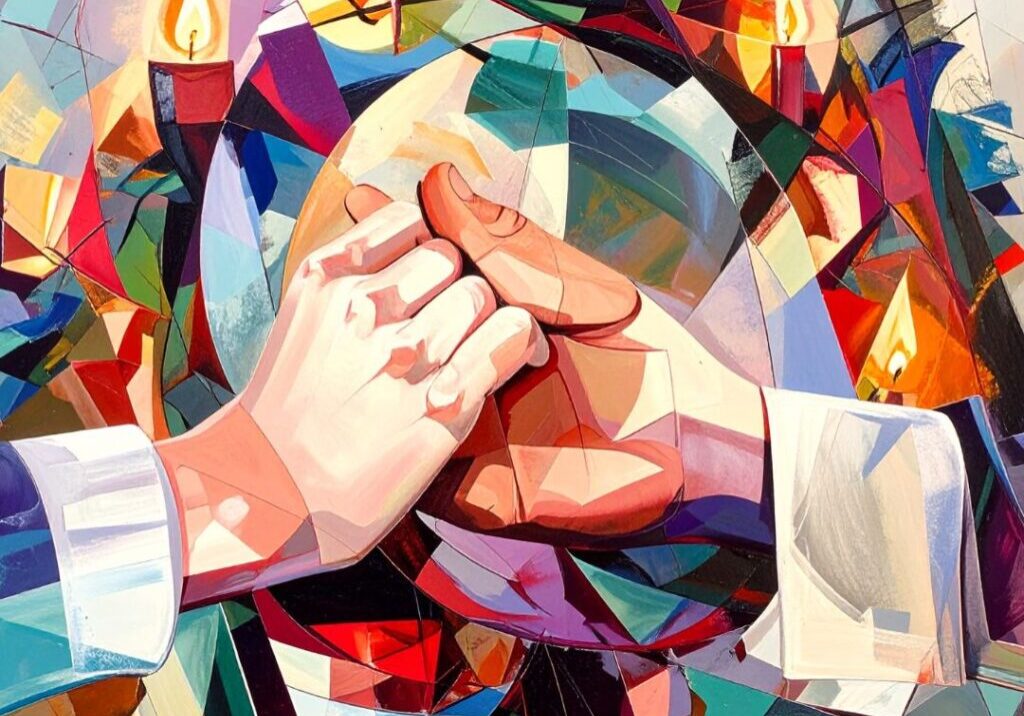Love Is The Answer – What Is The Question?
“I was a hidden treasure and I longed to be known. And so I created the world, both visible and invisible.”
This famous saying from the Hadith Qudsi, the extra-koranic sayings of Islam, speaks to the question of why God would want to bring creation into existence in the first place. Astonishingly, the reason given is not for majesty or dominion, but for intimacy, the yearning for self-disclosure, to know and be known. Seeded into the cosmos is that same primordial yearning, reverberating as a psychic harmonic of the big bang.
Teilhard de Chardin probably never encountered this quote. His familiarity with Islam was painfully limited, particularly in its mystical and Sufi branches with which he was ironically so deeply in tune. But in a real sense, this little gem of Islamic wisdom almost perfectly encapsulates Teilhard’s own magisterial understanding of cosmic love, transparency, and the personal.
How did we get to be here? How did anything get to be here? Teilhard judiciously sidesteps the classic metaphysical stipulation of a fall, an “involution” into matter. As a scientist rather than a metaphysician, he does not have to begin with the grand “why” of things; the “what” of them will suffice. And what he actually observes seeded into the stuff of the universe is a paradoxical dialectic: intense atomicity, granulation, the myriad bits and pieces of our materiality—and yet, at the same time, an underlying unity, and a force calling the “unorganized multitude” to move in the direction of “the unified multiple.”(HP, 28) However the pieces may have gotten broken in the first place, what he observes everywhere in the universe is a countering force—he names it love—moving beneath the pixilated surface drawing all things together. “Driven by the force of love,” he writes, “the fragments of the universe [continuously] seek each other so that the world may come into being.”
For Teilhard, love is not first and foremost a sentiment, let alone a sentimentality. It is first and foremost a geophysical force, built into the very structure of the cosmos. In an astonishing one-liner toward the end of The Human Phenomenon he writes:
“In all its nuances, love is nothing more or less than the direct or indirect trace marked in the heart of the element by the psychic convergence of the universe upon itself. “ (HP 188).
In other words, if you’re familiar with his theories of complexification and convergence, he’s saying that this primordial impulse toward unification (experienced at the biophysical level as attraction and at the psychic as eros) actually has its antecedent in the physical shape of our planet itself, its perfect sphericity inherently designed to shove things closer and closer together so that they converge, complexify, and grow more conscious. Whether by chance, “intelligent design,” or its own innate teleology, the whole thing seems to be set up like a cosmic gristmill for the extraction of consciousness.
When we love, then—when our own hearts reach out in tenderness, desire, or plain old physical attraction—Teilhard asks us to remember that the cosmos, too, passed this way, seeking at the macro-level what we are now experiencing at the micro.  We are in each another holographically, this world and us: the whole of the “universe story” carved in our own hearts, and the whole of our own story reverberating within the cosmic heart.
We are in each another holographically, this world and us: the whole of the “universe story” carved in our own hearts, and the whole of our own story reverberating within the cosmic heart.
Like that great other cosmological visionary Jacob Boehme (1585-1624), Teilhard has a penchant for moving back and forth very quickly between the physical and psychic realms. What for Boehme is friction at a physical level very quickly becomes anguish at an emotional level; hence he can speak of the anguish of creation awakening to itself. In a similar way Teilhard moves between the “outside” of things and their “inside.” From the outside perspective, love is a form of energy. It is an aspect—no doubt the primary aspect—of what he calls radial energy, the energy of evolution, the energy released in the process of complexification/consciousness. It is the force that runs through the cosmos as an energetic countercurrent to the Second Law of Thermodynamics, drawing things to become more unified, vitalized, and whole. From the inside— the psychic perspective—love retains its traditional meanings of compassion, intimacy, and generativity, drawing things to become more deeply themselves—“I am, may you be also,” as Beatrice Bruteau’s concisely summarizes it. But it also conveys for Teilhard an additional connotation: spiritualization, which means the release of yet another quantum packet of that sum total of consciousness and conscience (and in French they are the same word!) seeded into the cosmos in that initial eclosion of divine yearning that launched the whole journey in the first place.
When Teilhard speaks of “harnessing the energy of love,” he is speaking in both senses, both inside and outside. In the end, they are holographically embedded in one another, so the bridge between the cosmic processes and our own hearts is trustworthy.
Thus, we can look to our own hearts to tell us more about what Teilhard sees as the essence of the complexification/consciousness process—and hence, of evolution (and hence, of love): his insistence that “union differentiates.” We often think of love in terms of merging, uniting, becoming one, but Teilhard was wary of such definitions; his practiced eye as an evolutionist taught him something quite different. True union—the ultimate chef d’oeuvre of love—doesn’t turn its respective participants into a blob, a drop dissolving in the ocean. Rather, it presses them mightily to become more and more themselves: to discover, trust, and fully inhabit their own depths. As these depths open, so does their capacity to love, to give-and-receive of themselves over the entire range of their actualized personhood.
The term “codependency” was not yet current in Teilhard’s day, but he already had the gist of it intuitively. He knew that love is not well served by collapsing into one another. It is better served by standing one’s own ground within a flexible unity so that more, deeper, richer, facets of personhood can glow forth in “a paroxysm of harmonized complexity” (HP, 184.)
The poet Rilke, Teilhard’s contemporary and in many respects kindred spirit, is on exactly the same wavelength. “For what would be a union of two people who are unclarified, unfinished, and still incoherent?” he asks in his Letters to a Young Poet. “Love is a high inducement for the individual to ripen, to become something in himself, to become world, to become world in himself for the sake of another.”
 “To become world in oneself for the sake of another…” Hmmmm. Does love really ask us to become world? Does love make worlds? Is that what love does?
“To become world in oneself for the sake of another…” Hmmmm. Does love really ask us to become world? Does love make worlds? Is that what love does?
True, Teilhard does not directly tackle the question of first causes. But a clue to the cosmological riddle is surely embedded in his understanding of love as the driveshaft of evolution. Suppose this love is not a pre-existent “property” attributable to God, as in the classic substance theology of the past. Suppose it is instead an alchemical process: a tender and vulnerable journey of self-disclosure, risk, intimacy, yearning, and generativity whose ley lines are carved into the planet itself. The whole universe story has come into being because God is a hidden treasure who longs to be known. And the way— the only way— this knowing can be released is in the dance of unity-in-differentiation which is the native language of love. If it takes a whole village to raise a child, it takes a whole cosmos to bear forth the depths of divine love.
 View print-friendly version
View print-friendly version
4 Comments
Related Posts

Rewiring Our Lives Together, the Franciscan Way
The Season of Incarnation We are in the season of Incarnation—God becoming flesh. It is a beautiful time of the year that brings out the best of humanity, even in…


The following was recently sent to us to post in response to this blog by Cynthia Bourgeault.
Thank you so much for offering your reflections. We’re so encouraged to hear you are gathering in a group to collectively explore and consider these materials!
Blessings,
Eileen, on behalf of the Omega Center
___________________________________
Article: Love is the Answer-What is the Question?
Dear Omega Center:
We formed an Omega Discussion Group with the sisters in the Ritiro of the Franciscan Sisters of Allegany: Srs. Ann, Beth, Eleanor and Carol in Allegany, NY and myself Sr. Paula Franciscan Sister of Washington DC from St. Bonaventure University, St. Bonaventure, NY. The article chosen for our first gathering was Cynthia Bourgeault’s, Love is the Answer-What is the Question?
Some Shared reflections:
• A consciousness of conscious- eye opening intimacy to go within and deepening the heart vs. the head
• The sense of seeding: We are seeding working in unity to a convergence of oneness
• As humans a focusing on coming together in unity with the cosmos
• The Title of the article: Love is the Answer-What is the Question?- What took us so long to get it our DNA is that DNA of the universe-becoming ever shaped by and with the universe
• Human consciousness is just part of it all-as one becoming closer together does the universe expand
• The answer we have been seeding for the whole universe
• It truly is a dance of life searching for the unity-in-differentiation which the language of love.
This is a remarkable article. Threads gathered through the heart and woven in such a way that “more” is perceived. My own heart stopped when I read, “Suppose this love is not a pre-existent “property” attributable to God, as in the classic substance theology of the past. Suppose it is instead an alchemical process: a tender and vulnerable journey of self-disclosure, risk, intimacy, yearning, and generativity whose ley lines are carved into the planet itself. The whole universe story has come into being because God is a hidden treasure who longs to be known. And the way— the only way— this knowing can be released is in the dance of unity-in-differentiation which is the native language of love.” In other words…our deep, committed participation is essential to love’s continual emergence. Power, Word manifesting, the Fire of life itself calls us forth into participation. “The world is a-building.” (loved the reference to “ley lines”)
I am deeply moved. Intuitively, a glimpse of love as paradox. When we love, we feel unified with the world as we co-create a new world. “Union differentiates”. An enlightening expression of paradoxical love as a cosmological force.
Thank you for this post. I think it’s awesome that God is yearning to be known. In my own life, I have had experiences which I can only explain as God seeking me out and caring about me personally. They have helped me keep trying when I have had difficulty reconciling my faith with science. I love that in these blog posts we are taking science and nature seriously. It’s so cool that the whole universe story brings forth divine love. I’m looking forward to learning more about this.